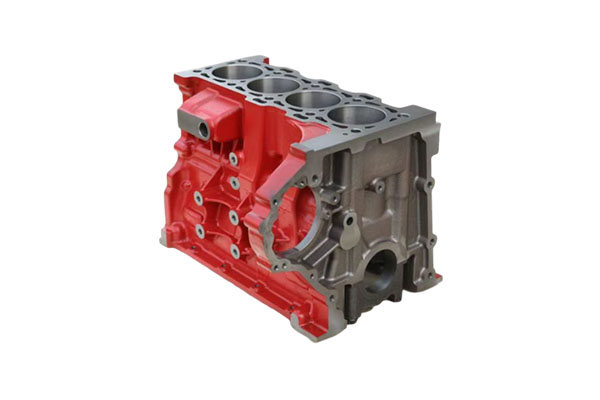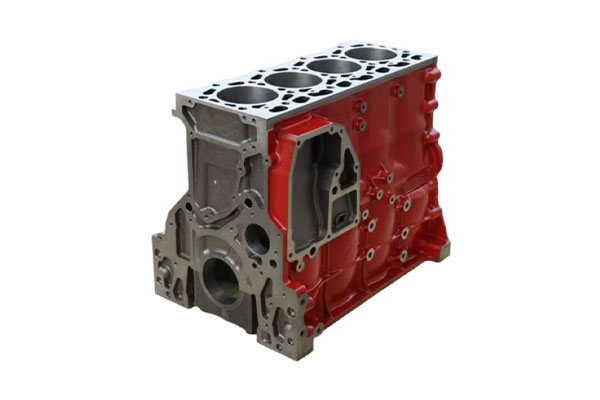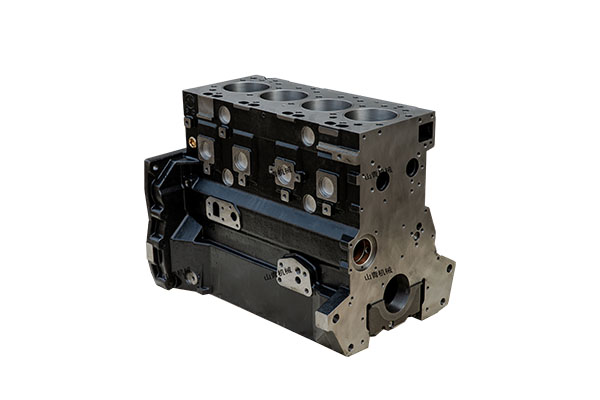How does the cylinder head help reduce emissions?
Release Time : 2025-07-01
As global attention to environmental protection increases, automakers and engine designers are constantly looking for new ways to reduce vehicle emissions. As an important part of the engine, the design and manufacturing process of the cylinder head are crucial to reducing emissions.
1. Optimizing combustion efficiency
Combustion efficiency is one of the key factors affecting engine emission levels. In traditional engine designs, due to the imperfect shape of the combustion chamber or the uneven mixing of fuel and air, some fuel may not be completely burned, resulting in harmful gases such as carbon monoxide (CO), nitrogen oxides (NOx) and particulate matter (PM). Modern cylinder head design can significantly improve combustion efficiency by improving the shape of the combustion chamber and the layout of the intake and exhaust ducts.
For example, the use of a compact combustion chamber design can shorten the flame propagation path and make the fuel burn more fully. In addition, optimizing the position and angle of the intake and exhaust valves can help achieve a better swirl effect, further improve the quality of the fuel-air mixture, and ensure that every drop of fuel can be fully utilized. These improvements not only reduce the proportion of unburned fuel, but also reduce the generation of harmful substances, thereby effectively reducing exhaust emissions.
2. Advanced Cooling System
The high temperature generated when the engine is working will have an adverse effect on the combustion process, resulting in the formation of local overheating areas, which will in turn cause knocking, which will not only damage engine components, but also increase the amount of NOx generated. Therefore, an effective cooling system is crucial to controlling the combustion temperature.
The cylinder head usually contains a complex network of cooling water channels to remove the heat generated during the combustion process. In recent years, engineers have developed a series of innovative cooling technologies, such as complex cooling channels manufactured by 3D printing, which can provide more efficient heat dissipation without affecting structural strength. This design of precisely controlling the coolant flow path makes the temperature of the combustion chamber wall more uniform, avoids the occurrence of hot spots, thereby reducing the possibility of knocking and reducing NOx emissions.
3. Variable Valve Timing and Lift Technology
The fixed valve timing and lift settings in traditional engines make it difficult to achieve optimal combustion efficiency under all operating conditions. To overcome this limitation, many modern engines use variable valve timing (VVT) and variable valve lift (VVL) technology. These technologies allow the valve opening time and amplitude to be dynamically adjusted according to the different operating states of the engine to optimize the intake volume and exhaust efficiency.
As the core component for installing the valves and their drive mechanisms, the cylinder head plays a decisive role in achieving the above functions. By integrating the advanced VVT/VVL system, the cylinder head can flexibly adjust the valve parameters according to actual needs to ensure that ideal combustion conditions can be obtained under various speed and load conditions. In this way, fuel economy can be improved while reducing pollutant emissions.
4. Integration of Exhaust Gas Recirculation (EGR) System
Exhaust Gas Recirculation (EGR) is a common emission reduction measure that reduces the combustion temperature and NOx generation by reintroducing part of the exhaust gas into the intake system to dilute the oxygen concentration in the fresh air. However, to achieve efficient and reliable EGR operation, the cylinder head needs to have corresponding channel and interface design.
The new cylinder head design takes into account the integration requirements of the EGR system and specially sets up an optimized exhaust gas channel to ensure that the exhaust gas can smoothly enter the intake manifold without interfering with the normal intake process. At the same time, by special treatment of the inner surface of the cylinder head, such as low-friction coating or precision machining, the resistance loss of exhaust gas in the channel can be reduced, and the efficiency of the entire system can be improved.
5. Application of lightweight materials
Reducing the weight of the engine can not only improve the power performance of the vehicle, but also indirectly help reduce emissions. This is because a lighter engine means that the overall mass of the vehicle is reduced, thereby reducing the energy consumption required during driving. In this regard, the choice of cylinder head material is particularly important.
Aluminum alloy is an ideal choice for replacing cast iron to make cylinder heads due to its low density and good thermal conductivity. Compared with traditional cast iron materials, aluminum alloy cylinder heads can significantly reduce weight while maintaining sufficient mechanical strength. In addition, aluminum cylinder heads also have better thermal conductivity, which is conducive to maintaining the stability of the internal temperature of the engine, indirectly promoting the improvement of combustion efficiency and reducing unnecessary emissions.
6. Intelligent sensors and control systems
In addition to hardware-level improvements, software control is also an indispensable part of reducing emissions. Modern engines are equipped with a variety of sensors for real-time monitoring of key parameters such as oxygen content, temperature, pressure, etc., and feeding data back to the electronic control unit (ECU). Based on this information, the ECU can quickly make adjustments to optimize parameters such as injection volume and ignition timing to ensure that the engine is always in the best working condition.
The cylinder head is integrated with multiple sensor interfaces to facilitate the installation of various monitoring devices. For example, the oxygen sensor can directly measure the oxygen concentration in the exhaust gas and provide accurate data support for the closed-loop control system; while the temperature sensor can help monitor the operating temperature of the cylinder head to prevent overheating. Through these intelligent means, the engine can automatically adjust the operating mode under different working conditions to minimize the emission of harmful substances.
In summary, the cylinder head plays an extremely important role in reducing engine emissions. From optimizing combustion efficiency to integrating advanced cooling systems, to applying lightweight materials and integrating intelligent sensors, every link is contributing to achieving lower emission targets.
1. Optimizing combustion efficiency
Combustion efficiency is one of the key factors affecting engine emission levels. In traditional engine designs, due to the imperfect shape of the combustion chamber or the uneven mixing of fuel and air, some fuel may not be completely burned, resulting in harmful gases such as carbon monoxide (CO), nitrogen oxides (NOx) and particulate matter (PM). Modern cylinder head design can significantly improve combustion efficiency by improving the shape of the combustion chamber and the layout of the intake and exhaust ducts.
For example, the use of a compact combustion chamber design can shorten the flame propagation path and make the fuel burn more fully. In addition, optimizing the position and angle of the intake and exhaust valves can help achieve a better swirl effect, further improve the quality of the fuel-air mixture, and ensure that every drop of fuel can be fully utilized. These improvements not only reduce the proportion of unburned fuel, but also reduce the generation of harmful substances, thereby effectively reducing exhaust emissions.
2. Advanced Cooling System
The high temperature generated when the engine is working will have an adverse effect on the combustion process, resulting in the formation of local overheating areas, which will in turn cause knocking, which will not only damage engine components, but also increase the amount of NOx generated. Therefore, an effective cooling system is crucial to controlling the combustion temperature.
The cylinder head usually contains a complex network of cooling water channels to remove the heat generated during the combustion process. In recent years, engineers have developed a series of innovative cooling technologies, such as complex cooling channels manufactured by 3D printing, which can provide more efficient heat dissipation without affecting structural strength. This design of precisely controlling the coolant flow path makes the temperature of the combustion chamber wall more uniform, avoids the occurrence of hot spots, thereby reducing the possibility of knocking and reducing NOx emissions.
3. Variable Valve Timing and Lift Technology
The fixed valve timing and lift settings in traditional engines make it difficult to achieve optimal combustion efficiency under all operating conditions. To overcome this limitation, many modern engines use variable valve timing (VVT) and variable valve lift (VVL) technology. These technologies allow the valve opening time and amplitude to be dynamically adjusted according to the different operating states of the engine to optimize the intake volume and exhaust efficiency.
As the core component for installing the valves and their drive mechanisms, the cylinder head plays a decisive role in achieving the above functions. By integrating the advanced VVT/VVL system, the cylinder head can flexibly adjust the valve parameters according to actual needs to ensure that ideal combustion conditions can be obtained under various speed and load conditions. In this way, fuel economy can be improved while reducing pollutant emissions.
4. Integration of Exhaust Gas Recirculation (EGR) System
Exhaust Gas Recirculation (EGR) is a common emission reduction measure that reduces the combustion temperature and NOx generation by reintroducing part of the exhaust gas into the intake system to dilute the oxygen concentration in the fresh air. However, to achieve efficient and reliable EGR operation, the cylinder head needs to have corresponding channel and interface design.
The new cylinder head design takes into account the integration requirements of the EGR system and specially sets up an optimized exhaust gas channel to ensure that the exhaust gas can smoothly enter the intake manifold without interfering with the normal intake process. At the same time, by special treatment of the inner surface of the cylinder head, such as low-friction coating or precision machining, the resistance loss of exhaust gas in the channel can be reduced, and the efficiency of the entire system can be improved.
5. Application of lightweight materials
Reducing the weight of the engine can not only improve the power performance of the vehicle, but also indirectly help reduce emissions. This is because a lighter engine means that the overall mass of the vehicle is reduced, thereby reducing the energy consumption required during driving. In this regard, the choice of cylinder head material is particularly important.
Aluminum alloy is an ideal choice for replacing cast iron to make cylinder heads due to its low density and good thermal conductivity. Compared with traditional cast iron materials, aluminum alloy cylinder heads can significantly reduce weight while maintaining sufficient mechanical strength. In addition, aluminum cylinder heads also have better thermal conductivity, which is conducive to maintaining the stability of the internal temperature of the engine, indirectly promoting the improvement of combustion efficiency and reducing unnecessary emissions.
6. Intelligent sensors and control systems
In addition to hardware-level improvements, software control is also an indispensable part of reducing emissions. Modern engines are equipped with a variety of sensors for real-time monitoring of key parameters such as oxygen content, temperature, pressure, etc., and feeding data back to the electronic control unit (ECU). Based on this information, the ECU can quickly make adjustments to optimize parameters such as injection volume and ignition timing to ensure that the engine is always in the best working condition.
The cylinder head is integrated with multiple sensor interfaces to facilitate the installation of various monitoring devices. For example, the oxygen sensor can directly measure the oxygen concentration in the exhaust gas and provide accurate data support for the closed-loop control system; while the temperature sensor can help monitor the operating temperature of the cylinder head to prevent overheating. Through these intelligent means, the engine can automatically adjust the operating mode under different working conditions to minimize the emission of harmful substances.
In summary, the cylinder head plays an extremely important role in reducing engine emissions. From optimizing combustion efficiency to integrating advanced cooling systems, to applying lightweight materials and integrating intelligent sensors, every link is contributing to achieving lower emission targets.







